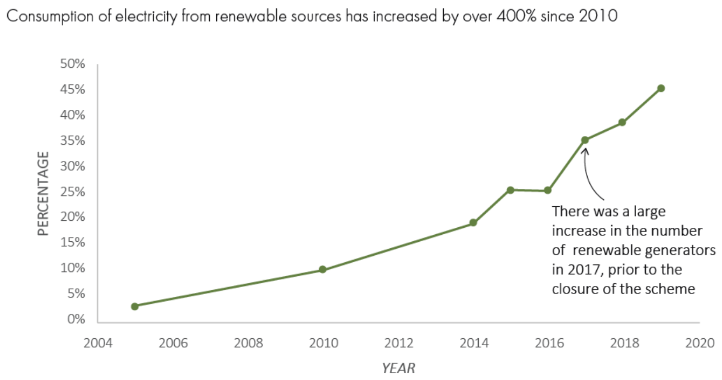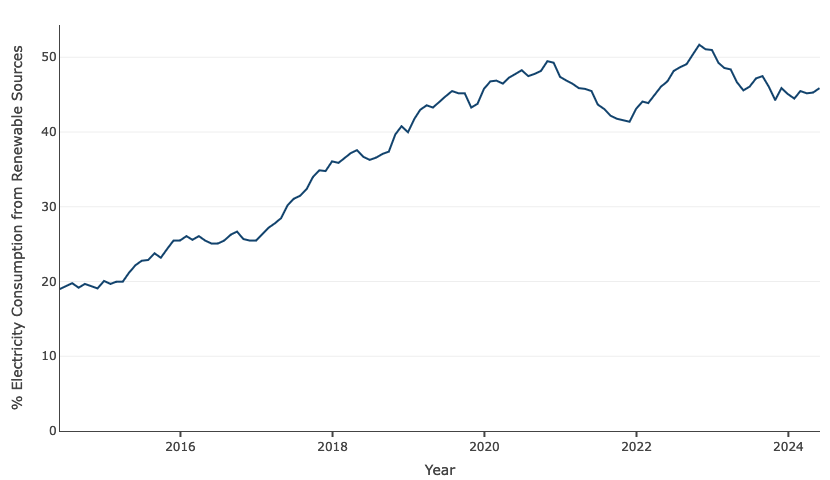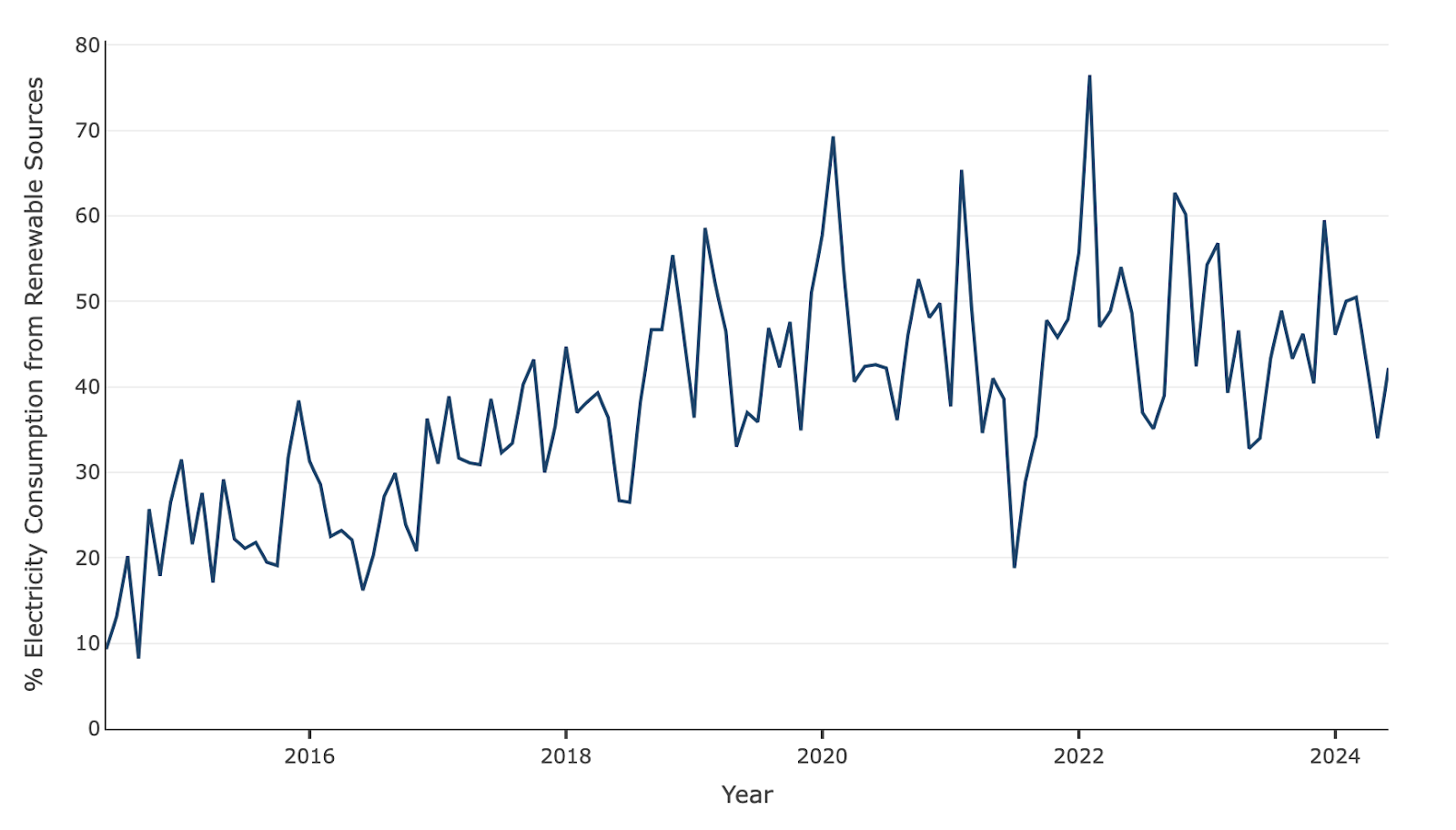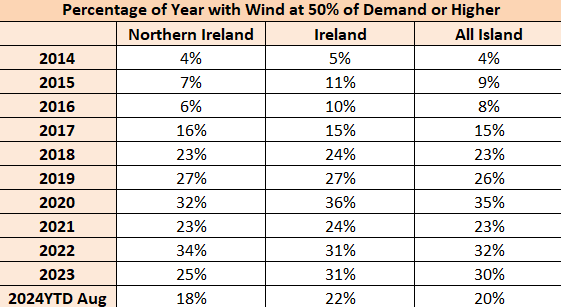Official data indicates that NI currently generates about 45% of the electricity it needs from renewable sources.
The 80% target by 2030 is a commitment within the 2022 Climate Change Act.
It is inaccurate to say that NI reached 40% renewables in 2016. That year saw a monthly average of 25.2% of electricity from green sources – meaning renewables have seen an increase of around 20 percentage points (pp) in the past eight years, based on figures from NISRA.
Electricity generation from renewables can vary significantly from month to month, but even at its monthly peak in 2016 (December) green sources only got to 36.3% of total electricity.
However, this does not mean that NI is on track to meet the 2030 commitment. Growth at the same pace – 20pp in eight years – would mean 65% renewables in 2032. Assuming steady growth (which is not guaranteed), this would fall short of the 80% required in 2030.
During an Assembly debate on green growth on 17 September, MLAs from the Alliance Party and the DUP made identical claims about Northern Ireland’s renewable energy targets. The Alliance Party’s Andrew McMurray said:
“We currently get about 45% of our electricity consumption from renewable sources and have a statutory target of achieving 80% by 2030. We made good, strong progress between 2005 and 2016, which helped us to exceed the target of 40% by 2020, but, since then, we have really slowed down. In fact, in the eight years since 2016, we have added only 5%. We now have only six years left to make up the remaining 35% that we will need in order to meet our target, which is concerning.”
Shortly afterwards, Deborah Erskine of the DUP – who chairs the Assembly’s Committee for Infrastructure, of which Mr McMurray is also a member – said:
“We have ambitious targets contained in the Climate Change Act 2022, representing a target of 80% renewables by 2030. We sit at 45% renewables, as has been outlined in the Chamber today. Without intervention in our planning system, that target is far out of reach. Mr McMurray must have been reading my notes before coming into the Chamber today, because he is right in saying that, between 2016 and now, our electricity from renewable sources went up by just 5%. In a six-year time frame, we have to increase that by 35%, which is a huge challenge.”
This fact check focuses on three different aspects:
NI currently gets about 45% of its electricity from renewable sources;
Northern Ireland has a target of 80% renewable energy usage by 2030, meaning this needs to increase by another 35 percentage points (pp); and
by 2016, we achieved 40% renewables, meaning generation as a percentage of electricity used has increased by only 5pp in the past eight years.
The first and second of these claims are supported by evidence.
Official data published by the Northern Ireland Statistics and Research Agency (NISRA) indicates that NI does currently generate about 45% of the electricity it uses from renewable sources, while the 80% target for 2030 is a commitment contained in the Climate Change Act (Northern Ireland) 2022 – and, therefore, renewables need to account for another 35% of local electricity usage in six years for that target to be met.
What about recent growth? How has the proportion of electricity consumption that comes from green sources risen in recent years?
According to NISRA figures, the 2016 electricity consumption from renewables saw a monthly average of 25.2% – not 40%, as per the claim. Furthermore, while this proportion varied throughout the year, there was not a single month where 40% of NI’s electricity consumption was green.
This means that renewables generation as a percentage of demand has risen by about 20 percentage points (pp) in the past eight years, not 5pp.
However, it is worth noting that, if renewables grow at that pace (20pp over eight years) it means NI will hit 65% renewables in 2032 and – assuming a steady rate of growth (which is not necessarily what will happen) – miss its 2030 commitment.
Let’s take a closer look.
FactCheckNI contacted both MLAs in question. Each pointed us to a meeting of the Infrastructure Committee featuring submissions from ABO Energy, Renewable Energy Systems (RES) and RenewableNI.
This meeting took place on 26 June and during the session John Boyce from RES told the committee:
“[We] got to 40% of electricity from renewable sources in 2016 off the back of the Northern Ireland renewables obligation (NIRO) scheme. We now have a target of 80% by 2030. As of today, we are at about 45%, so, in the eight years since 2016, we went up 5%, and we have six years to make up the remaining 35%.”
Let’s dig into the data.
The first aspect of this claim concerns NI’s current renewables usage. Both MLAs stated that we currently get about 45% of our total electricity from green sources. Is this right?
The Northern Ireland Statistics and Research Agency (NISRA) produces official data about this. Its most recent report, Electricity Consumption and Renewable Generation in Northern Ireland, was published on 5 September, just under two weeks before the Assembly debate, and stated that NI had an average of 45.8% electricity consumption from metered renewable sources between July 2023 and June 2024. The report notes that data is not gathered on some forms of renewable generation that are not metered (microgenerators) or do not export electricity to the grid (non-export stations).
Based on the 12-month average, it is fair to say that the first aspect of this claim is supported by evidence.
The second aspect concerns whether NI has a target of 80% renewable usage by 2030.
In short, it does.
This target is part of the Climate Change Act (Northern Ireland) 2022. According to PART 1, sectoral plans, section 15 of the Act:
“The Department for the Economy must ensure that at least 80% of electricity consumption is from renewable sources by 2030.”
And, given that current renewable usage is around 45% and the 2030 target is 80%, it is obvious that an increase of 35pp is required.
Therefore the second aspect of this claim is also backed by evidence.
What about progress? How have renewables grown in NI over time?
The claim itself centres on increases in green energy since 2016 but let’s start with a longer view.
In 2005, the Northern Ireland Renewables Obligation scheme (NIRO) was launched, providing financial incentives for renewable electricity development and production in order to mitigate costs for consumers.
The following graph, from an October 2020 report entitled Generating Electricity from Renewable Energy published by the Northern Ireland Audit Office (NIAO), shows the percentage of NI’s electricity consumption that was sourced from renewables for the years 2005 to 2020:

Figure 1 – source: NIAO
This arguably reflects the “good, strong progress” mentioned by Mr McMurray in his comments – although this appraisal is not central to this fact check.
However, what is a key part of this check is the percentage of NI’s electricity consumption produced by green methods in the year 2016 which, according to that graph, is somewhere around 25%. Let’s take a closer look.
NISRA’s September’s report Electricity Consumption and Renewable Generation in Northern Ireland shows rolling 12-month averages of NI’s renewable electricity generation as a percentage of electricity consumption in Northern Ireland from June 2014 to June 2024:

Figure 2 – source: NISRA
According to official data for rolling 12-month averages of green energy usage, the percentage of electricity consumption from renewables in 2016 was at an average of 25.2% (January 2016 to December 2016) – not 40%, as per the claim.
Based on these figures, it is also inaccurate to say that green energy consumption only grew by 5pp between 2016 and 2024. In fact, the growth averages out at around 20pp.
Rolling averages and monthly spikes
The reason the rolling month is included is because there are multiple variables which will impact upon the generation of renewable energy. In general, by looking simply at individual months there is a risk of reading too much into outliers that see either fallow renewable usage or significant green spikes.
Rolling 12-month averages (where, for each month, the final figure is the average of the preceding 12 months) smooth out data to provide a clearer picture of longer-term trends.
In fact, data focusing on individual months, rather than rolling annual averages, might explain where any misconceptions arose with this claim.
As well as data on 12-month rolling averages, NISRA’s September report also contains data on monthly renewable electricity generation as a percentage of electricity consumption in Northern Ireland from June 2014 to June 2024:

Figure 3 – source: NISRA
Focusing on monthly data in isolation, we see that the percentage of electricity consumption from renewables was 38.4% in December 2015 while in June 2024, it was 42.2%.
The figure for January 2016 was 31.3%, a 7.1pp fall from one month to the next, indicating how volatile monthly figures can be compared with rolling annual averages. Official data indicates that, throughout 2016, the percentage of electricity consumption that was generated by renewables moved between a monthly low of 16.2% (June) and a monthly high of 36.3% (December).
To reiterate what the data shows: it is inaccurate to say that renewables accounted for 40% of electricity generated in 2016 and similarly inaccurate to say there has only been a 5pp growth in renewable generation as a proportion of total electricity used in the eight years since.
Infrastructure Committee and RES response
After the MLAs involved this claim directed us to the Infrastructure Committee meeting where the statistics they quoted were mentioned, FactCheckNI contacted Renewable Energy Systems (RES) to ask about the information provided to MLAs.
The organisation responded to us by saying: “There were periods of time where wind met more than 40% of demand in 2016,” and by sending us an excerpt from a table from EirGrid’s datahub:
The full table shows the percentage of any given year when wind accounts for more than half of total demand.

Figure 5 – source: EirGrid
As a side note, this data only mentions wind – which provides the main source of NI’s green electricity (currently 82.3%, according to NISRA) but not all of it. It omits other sources including biomass, biogas and – would you believe it? – even solar.
However, ultimately the issue here is that comparing the fact that in 2016 there were points in time when renewables accounted for more than 40% (indeed, 50%) of electricity consumption to the fact that in 2024 they account for around 45% of electricity consumption in general is not comparing like with like and can be misleading.
It is certainly not accurate to say that this provides good evidence that “in the eight years since 2016, we went up 5%” (which, from the context, was talking about renewable generation as a percentage of total energy consumed annually).
While the claim that renewables have only seen 5pp growth in eight years is inaccurate, that does not mean that Northern Ireland is necessarily well on course to hit its 2030 target of 80% of electricity generated by renewables.
In the past eight years, there has been around 20pp of growth. If that same level of growth is seen again over the next eight years, we will sit at around 65% renewables in 2032.
Assuming steady growth over that time, NI would miss the 2030 target.
However, another wrinkle in all this is that renewable usage does not necessarily see steady growth. This goes beyond monthly ups and downs that are to be expected. Figure 2 above shows a significant slump beginning towards the end of 2020.
Whatever the reasons behind that (the research for this article did not explore that, including whether the pandemic was or was not a factor), it shows that significant dips can happen.
